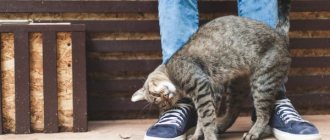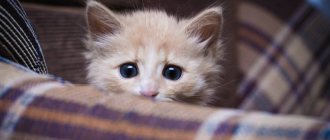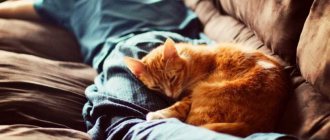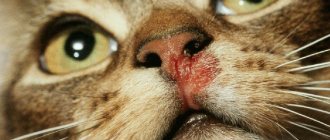6870Administration
The domestic cat differs from the wild one in having a more docile character. He easily makes contact with people and gladly allows himself to be taken care of. But sometimes it still shows a certain wildness in its behavior, which is expressed in the fact that the cat growls and hisses at the members of the family in which it lives. And if at first this behavior even slightly amuses some owners, then with regular and frequent manifestation of aggression in this way, any owner begins to think about its causes and possible consequences. Especially if there is a small child in the family.
Psychological reasons
The cat expresses the entire range of its emotions exclusively through body language, periodically supplementing it with several vocal variations available to it. There are few of them, but with their help the animal manages to convey to humans a huge number of experiences that need correct interpretation.
Predator instinct
It is embedded in every, even the most affectionate little cat, in whose veins flows the blood of distant forest ancestors . If you remind your cat of her hunting reflexes every day, don’t be surprised that over time she will turn into an angry, growling fury.
Important! You should not ask your cat to track the movements of your arm/leg under the blanket: she will get used to attacking without a reason, not realizing that it was a game.
You have awakened a predator in your pet if it:
- jumps on your legs from ambush;
- does not respond to your shout, increasing the pressure;
- bites, hisses and scratches.
Correcting this behavior will be very difficult.
Social aggression
It occurs if a person annoys with excessive caresses. Any cat behaves quite coolly until it wants the owner’s tenderness. She will come up to attract attention, begin to rub against your legs, caress, prop up her back or ask to be held.
But tenderness (according to the cat) must be dosed - as soon as you overdo it with caresses, he will turn from an angel into a devil. At this moment, he is able to bite his hand, hiss and rattle his tail in displeasure, showing that the limit of his patience has been exhausted.
Frustration
This feline condition is akin to a human one and occurs when the pet’s desires do not coincide with its capabilities.
This is interesting! Zoologists have suggested that frustration is characteristic of kittens weaned early from their mother's breast. These animals do not know how to get food on their own and are constantly waiting for handouts, and when they don’t wait, they become aggressive.
Feline frustration is recognized by the following actions:
- the pet hisses at the owner whom he trusts;
- growls, assuming that he did not get a treat;
- screams loudly and rushes about the threshold.
The cat becomes frustrated if the owner is slow to feed, is in no hurry to open the front door, or moves away somewhat from the pet.
Redirected aggression
A similar state can be experienced by cats that are frightened/angry by something in the presence of a particular person.
This is interesting! It is not surprising that he causes unmotivated cat aggression by his very appearance. The animal is isolated and allowed to recover.
Thanks to excellent associative memory, a witness to an unpleasant incident turns into a source of negative memories for the cat.
Fear
A cat growls and hisses if it is fueled by fear due to insufficient socialization or, much worse, harassment and beatings (experienced from an early age).
If the growl is caused by fear, the markers of the latter will be:
- attacking people in the presence of a real/imaginary stimulus;
- growling, supplemented by paw swings;
- increased hissing/growling when the cat is cornered;
- clear warning postures;
- final accentuated licking of fur.
A cat whose fears originated in childhood needs increased attention and patience . She is not punished, but gently re-educated.
Resentment
This emotion is sometimes associated with fear, but often works autonomously. If a cat growls and hisses when it sees its owner, remember what caused the cat’s recent offense. The animal will ignore the offender or show its dissatisfaction openly, based on the severity of the offense. Talk to your pet so that the confrontation does not drag on, and be sure to sweeten your apology with a treat.
Domination
Once in the house, the animal will definitely build its own hierarchical scheme, headed by the leader: and it’s good if she chooses one of the household members, and not herself, to play the role of the latter. If a cat considers himself dominant in the family, he will immediately begin to prove his dominant role. Here he will come in handy with growls, hisses and claws, with the help of which he will repel all unauthorized attempts to enter his personal territory.
Important! Anyone who touches the cat's things (which can even be feces) will be attacked and expelled. That is why it is in the owner’s interests to point out to the cat its subordinate position from the first days.
She must recognize someone from the family as the alpha male: but this lucky person will not only be treated kindly, but will also feel the cat’s jealousy. The cat will try to be jealous of everyone who will enjoy his attention - relatives, friends, children and other domestic animals. Remember that cats have a hard time getting used to all the changes that occur in your family (departure, divorce, travel, or the birth of babies).
Ownership instinct
In general, possessiveness stems from the desire to dominate . This instinct is inherent in cats at the genetic level, and besides, the instinct of ownership in cats is superior in the brightness of its manifestation to a similar instinct observed in humans. The cat growls and hisses, demonstrating that it is she who is the master of the situation at this moment, not letting you (for example) near her favorite toy or a bowl of food.
If you see that you are dealing with the instinct of the owner, do not aggravate the situation, but move away. Growling/hissing often signals a possible escalation of conflict: the audible warning will be followed by a confrontation (with bites and scratches).
Return to content
Frustration
Frustration is a state in which a pet's needs are not met. Scientists believe that this disorder occurs if the kitten is not weaned off cat milk naturally.
As a result, the cat is not able to get its own food. He expects some kind of reward and growls if he doesn't get it. How to recognize this reason:
- the cat hisses at the owner, even if he trusts him;
- the pet growls if in any situation he did not get the desired reward;
- the cat did not receive mother's milk;
- The cat screams loudly and rushes around the door.
This also manifests itself when the owner does not serve food quickly enough, opens the front door, or simply moves away from the pet.
Injuries, illnesses
Your cat may look quite healthy, which does not at all exclude some diseases that are smoothed out or that arose not so long ago. Internal discomfort leads to unusual behavior, which is expressed, in particular, by unmotivated aggression.
This is interesting! If we are talking about illness, increased nervousness is often accompanied by refusal to eat/drink, apathy, frequent licking of fur and biting some parts of the body.
Tail biting
You may notice your pet trying to bite its tail and hear an angry hiss as it tries to prevent it. Sometimes the cat chews its tail at night, when everyone is lying down on the side.
The reasons for such a disorder can be various events:
- moving to a new apartment;
- birth of a baby;
- lack/decreased attention;
- other psychological trauma.
This kind of cat behavior must be stopped by getting to its source. Otherwise, the animal faces tail amputation.
Pregnancy
A cat growls and hisses when she is preparing to become a mother or immediately after giving birth to kittens, especially if a person has managed to undermine her trust. It will have to be restored, showing the pet that you will not hurt her or her offspring. As soon as the animal calms down, the aggressive attacks towards you will stop.
Anesthesia
A disruption in the cat’s usual behavior also occurs after undergoing general anesthesia . Animals have a hard time recovering from anesthesia and at this moment can behave very strangely, including hissing at their beloved owner. However, such a reaction is observed quite rarely, but no matter how the cat behaves, be there, stroke and calm it.
Return to content
Basic rules of education
There are 4 main types of aggression in cats:
- Territorial or social. Occurs when a foreign animal appears, as well as in conflicts between cats living in the same house.
- Defensive aggression to a negative stimulus. Occurs when a threat appears.
- False (game). It appears during play with other animals or with the owner.
- Aggression of excessive affection. Cats' skin receptors are highly sensitive, so prolonged stroking can cause pain in your pet.
All these types of aggression appear under the influence of certain reasons and require different methods of correction.
One of the most common causes of bites is lack of education. Contrary to popular belief, kittens can and should be raised if you want to get an adequate animal.
- Encouragement to chase a person or attack a person's arms or legs. During play, animals use teeth and claws. By playing with a kitten without special devices, you provoke the animal yourself, reinforcing an undesirable reaction.
- After a bite there is no adequate immediate punishment. Punishment for unacceptable behavior must follow immediately (within seconds). The stimulus used must be strong enough to quickly stop the unwanted behavior.
- Lack of communication. Provokes aggression towards people or animals.
- Insufficient physical activity. Provokes excessive aggressiveness during the game.
Persistence, consistency and patience are the main rules when weaning a kitten from bad habits.
We suggest you read: Struvite in the urine of a cat: how to treat it
Ways to fight
- From an early age, teach your kitten to play and bite only special toys. Encourage play of chase with only approved items. These can be moving, bouncing toys that can be chased.
- Stop playing if the kitten bites you.
- You can't learn the command. Cats are quite capable of learning and following prohibitive commands.
- Provide your kitten with adequate exercise. To do this, set aside a certain time every day for active games.
But here you can read about what you should never do.
Punishment should follow immediately after the bite. This is the only way to form a cause-and-effect relationship between a human bite and the onset of unpleasant consequences.
- Punishment should not be painful.
- Your reaction to bites should be constant and the same.
- Socialization problems and solutions.
Socialization
Socialization is an important aspect; the formation of a kitten’s character largely depends on it. This is not only communication, but also a model of subsequent behavior in any unclear situations.
Often an animal begins to bite in the following cases:
- on the street;
- at a veterinarian's appointment;
- during transportation;
- when a large number of guests arrive;
These are signs of insufficient socialization. Any unusual situation provokes the onset of a stressful state. The animal becomes aggressive and tries to bite upon any contact.
These problems can be avoided if proper adaptation is carried out in time.
Other factors
Other, very different circumstances also act as catalysts for growling and hissing.
Heredity
It is quite difficult to tame kittens that are born in the wild and have never met people. Such animals (especially at first) are afraid of people, hissing and growling.
Important! Do not forget that each cat has an individual character, the main features of which are determined by genes. If the kitten's father or mother had a quarrelsome and conflictual disposition, most likely he will inherit his parent's cockiness.
That is why, when going to the nursery, you need to observe (and not just for 5 minutes) how adult animals behave. Otherwise, a fighter will settle in your house, whose fighting character you will simply have to put up with.
Territory defense
The cat considers the whole house to be his own, highlighting particularly comfortable zones in it that are best not to be encroached upon. You returned after a long walk, and your pet is not happy about your arrival, turns up its nose and gets angry. The explanation is simple - he smelled a foreign odor from your clothes/shoes. For you, this is a trifle, but the cat may regard this as an enemy’s invasion of personal territory, in response to which it will begin to hiss and growl. It often comes to bites, and not only strangers suffer, but also the owners.
Provoking games
A cat growls and hisses if you flirted with it from an early age, exposing your arms and legs. This is the most dangerous reflex that should not be reinforced in an animal. With age, the habit of playing with the claws out will remain, and adult thoroughness will be added to it: the claws will become sharper, the teeth will be stronger, and bites and scratches will be much more noticeable.
This is interesting! Once the habit of dangerous gambling has taken hold, it will be very difficult to get rid of it. Psychologists advise not to succumb to provocations and show indifference when the cat attacks.
In order for your pet to cool down its warlike ardor, you can leave the room for a while . Scolding and, especially, hitting a cat is prohibited. This will lead to the opposite result - she will become embittered and even more aggressive.
Ochlophobia
Animals, like some people, are susceptible to ochlophobia (fear of crowds). Such pets cannot tolerate large gatherings and when they get into them, they begin to defend themselves, using growls/hisses as a warning.
A cat prone to ochlophobia does not like to play with children and change hands: ignore its warning signals, and it will attack. If you have a noisy company, take the cat to another room.
Return to content
The hiss of a cat defending territory
Cats are by nature solitary animals who value their independence.
In the house where he grew up, the cat feels like a master. When another animal appears in the home, especially a dog or kitten, the animal jealously defends its place in the house. This continues until a hierarchy is established. It is not uncommon for a four-legged animal to take out its irritation on its owner, and not on its competitor. The animal in such a situation is aggressive, this is indicated by hissing and often beating its tail. Aggression in a cat can be caused by the smell of another animal brought from the street. A change of housing can also cause his aggressiveness, as it disrupts the usual way of life. Situations are possible when a cat defines itself as the leader in the house, then it zealously defends its position through intimidation. He hisses and shows aggression in all possible forms whenever he touches objects that he considers his own or decides that there is an invasion of his territory. In such situations, the cat often attacks people.
How to respond to a growl
Several rules will help relieve tension between you and your cat, the choice of which depends on the cause of the conflict:
- if aggression is associated with illness, take your pet to the clinic;
- when demonstrating a fighting spirit, wait 10–15 minutes until the pet calms down (it is better to go to another room during this time);
- after the cat has come to its senses, pet it, talk to it and treat it to something tasty;
- do not stop the cat from growling at your brood - this is one of the methods of education;
- if the cat’s fighting qualities are innate, just come to terms with this fact - you won’t influence the genes, so accept and love your bully for who he is.
Return to content
Interspecies aggression
Anger caused by competition for territory, food or attention of the owner. In a group of animals (even if there are only 2 of them), there is always an “alpha” and her subordinates. Hierarchy is established through showdowns—hissing, displays of force, or even fights. However, from time to time a “subordinate” will claim the place of “alpha”. It happens that two pets live in perfect harmony, share a bowl, a bed and the affection of the owner, and suddenly, one cat shows aggression.
READ What types of mammoths do you know? Something about woolly mammoths
There are several reasons for anger:
- Competition for food or territory.
- Weakened "alpha" state.
You can't change nature and clashes will happen. Exit 2 - tolerate the pets' antics, risking their health, or sterilize the animals. After sterilization, one of the basic instincts in pets is dulled – sexual, which “removes” questions about defending territory or fighting for the hypothetical right to procreate.
Maternal aggression
Perhaps this is the only option when a person should not try to correct the behavior of an animal. An angry mother cat is capable of not only attacking, saving the lives of the kittens, the animal will “stand to the death” and fight to the last drop of blood. Before the attack, the mother emits a specific odor, elusive to the human sense of smell.
READ Why did my cat eat less? Why is the cat lethargic, sleeps all the time and eats little: diagnosis and treatment of the disease The cat sleeps all the time and is lethargic.
What to do if a cat that has recently given birth regularly attacks its owners? Firstly, be patient, and secondly, discover and eliminate the cause of the cat’s fears - move the nest to a quieter room, darken the room, refrain from receiving guests. If the cat is preparing to attack, retreat without turning your back to the animal, show open palms and do not try to speak, the mother’s priority is to eliminate the “enemy” without a fight.











